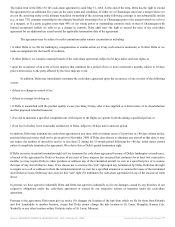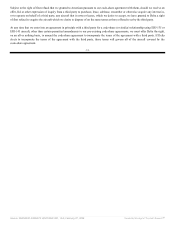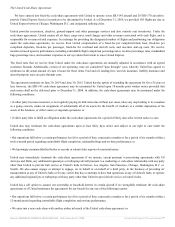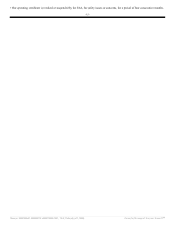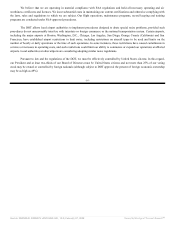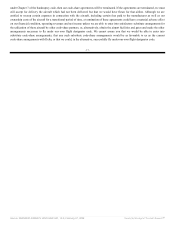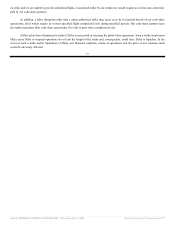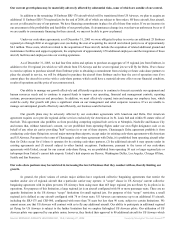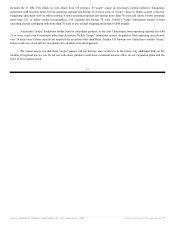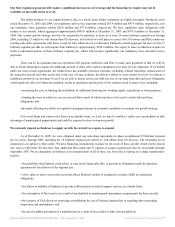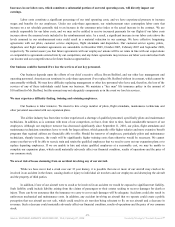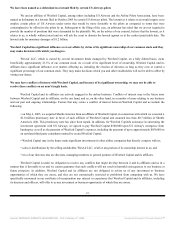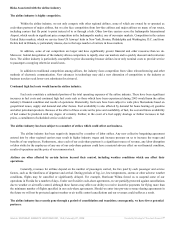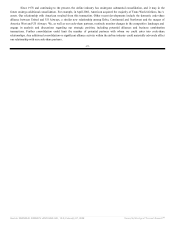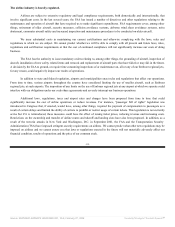Frontier Airlines 2005 Annual Report Download - page 35
Download and view the complete annual report
Please find page 35 of the 2005 Frontier Airlines annual report below. You can navigate through the pages in the report by either clicking on the pages listed below, or by using the keyword search tool below to find specific information within the annual report.
Our current growth plans may be materially adversely affected by substantial risks, some of which are outside of our control.
In addition to the remaining 18 Embraer ERJ-170 aircraft which will be transitioned from US Airways, we plan to acquire an
additional 11 Embraer ERJ-170 regional jets by the end of 2006, all of which are subject to firm orders. Of these aircraft, four aircraft,
are not yet allocated to any of our partners. We have financing commitments in place for all of these firm orders. If we are incorrect in
our assessment of the profitability and feasibility of our growth plans, if circumstances change in a way that was unforeseen by us or if
we are unable to consummate financing for these aircraft, we may not be able to grow as planned.
Under our code-share agreements, as of December 31, 2005 we were obligated to place in service an additional 25 Embraer
regional jets through 2006 at an aggregate cost (excluding the cost of acquiring the aircraft and related parts) to us of approximately
$6.3 million. These costs, which are related to the acquisition of these aircraft, include the acquisition of related additional ground and
maintenance facilities and support equipment, the employment of approximately 670 additional employees and the integration of those
aircraft, facilities and employees into our existing operations.
As of December 31, 2005, we had four firm orders and options to purchase an aggregate of 35 regional jets from Embraer, in
addition to the 18 regional jets which we will obtain from US Airways and the seven regional jets we will fly for Delta. If we choose
to exercise options to purchase aircraft from Embraer prior to obtaining a commitment from existing or future code-share partners to
place the aircraft in service, we will be obligated to purchase the aircraft from Embraer and to bear the cost of operation even if we
cannot place the aircraft in service with a code-share partner, which could have a material adverse effect on our financial condition,
results of operations and the price of our common stock.
Our ability to manage our growth effectively and efficiently requires us to continue to forecast accurately our equipment and
human resources needs and to continue to expend funds to improve our operating, financial and management controls, reporting
systems, procurement process and procedures. In addition, we must effectively expand, train and manage our employee base, which
could be costly. Our growth will place a significant strain on our management and other corporate resources. If we are unable to
manage our anticipated growth effectively and efficiently, our business could be harmed.
Our growth plans may be adversely affected by our code-share agreements with American and Delta. Our American
agreement requires us to provide regional airline services exclusively for American at its St. Louis hub and within 50 statute miles of
that hub. This agreement also prohibits us from providing competing regional hub services at Memphis, Nashville and Kansas City
and means that, without American's consent, we are prohibited from operating flights under our own flight designator code or on
behalf of any other air carrier providing "hub" services in or out of these airports. Chautauqua's Delta agreement prohibits it from
conducting code-share flying into several major metropolitan airports, except under its existing code-share agreements with American
and US Airways. Pursuant to the terms of Chautauqua's code-share agreement with Delta, it is prohibited from operating aircraft other
than for Delta except for (1) those it operates for its existing code-share partners, (2) the additional aircraft it may operate under its
existing agreements and (3) aircraft subject to other limited exceptions. Furthermore, pursuant to the terms of our code-share
agreements with United, except for our current code-share flying, we are prohibited from operating 50 seat or larger regional jets or
turboprops from United’s current hub airports. United’s hub airports are Denver, Washington Dulles, Los Angeles, Chicago O'Hare,
Seattle and San Francisco.
Our code-share partners may be restricted in increasing the level of business that they conduct with us, thereby limiting our
growth.
In general, the pilots' unions of certain major airlines have negotiated collective bargaining agreements that restrict the
number and/or size of regional aircraft that a particular carrier may operate. A "scope" clause in US Airways' current collective
bargaining agreement with its pilots prevents US Airways from using more than 465 large regional jets not flown by its pilots in its
operations. For purposes of this limitation, a large regional jet is an aircraft configured with 86 or more passenger seats. There are no
quantity limitations in the US Airways “scope” limitations for small regional jets. For purposes of this “scope” restriction, a small
regional jet is defined as any aircraft configured with 78 or fewer seats. US Airways can outsource up to an additional 55 aircraft,
including the ERJ-175 and CRJ-900, configured with more than 78 seats but less than 90 seats, subject to certain limitations. We
cannot assure you that US Airways will contract with us to fly any additional aircraft. Our ability to participate in additional regional
jet flying for US Airways is subject to the further limitation that we employ furloughed US Airways pilots. Our utilization of US
Airways pilots was approved by our pilots union; however, they limited their approval to 80 additional aircraft for US Airways which
Source: REPUBLIC AIRWAYS HOLDINGS INC, 10-K, February 27, 2006 Powered by Morningstar® Document Research℠


